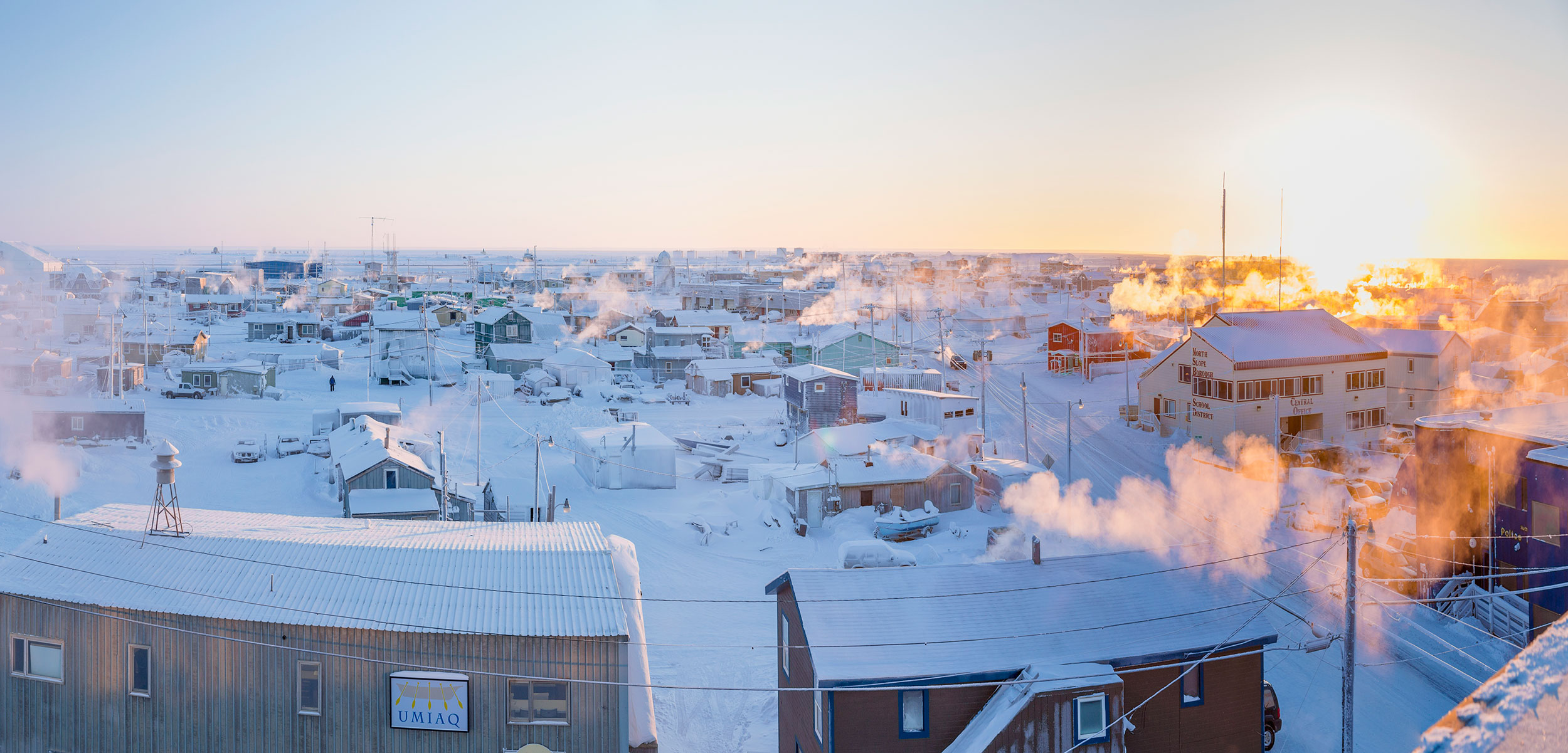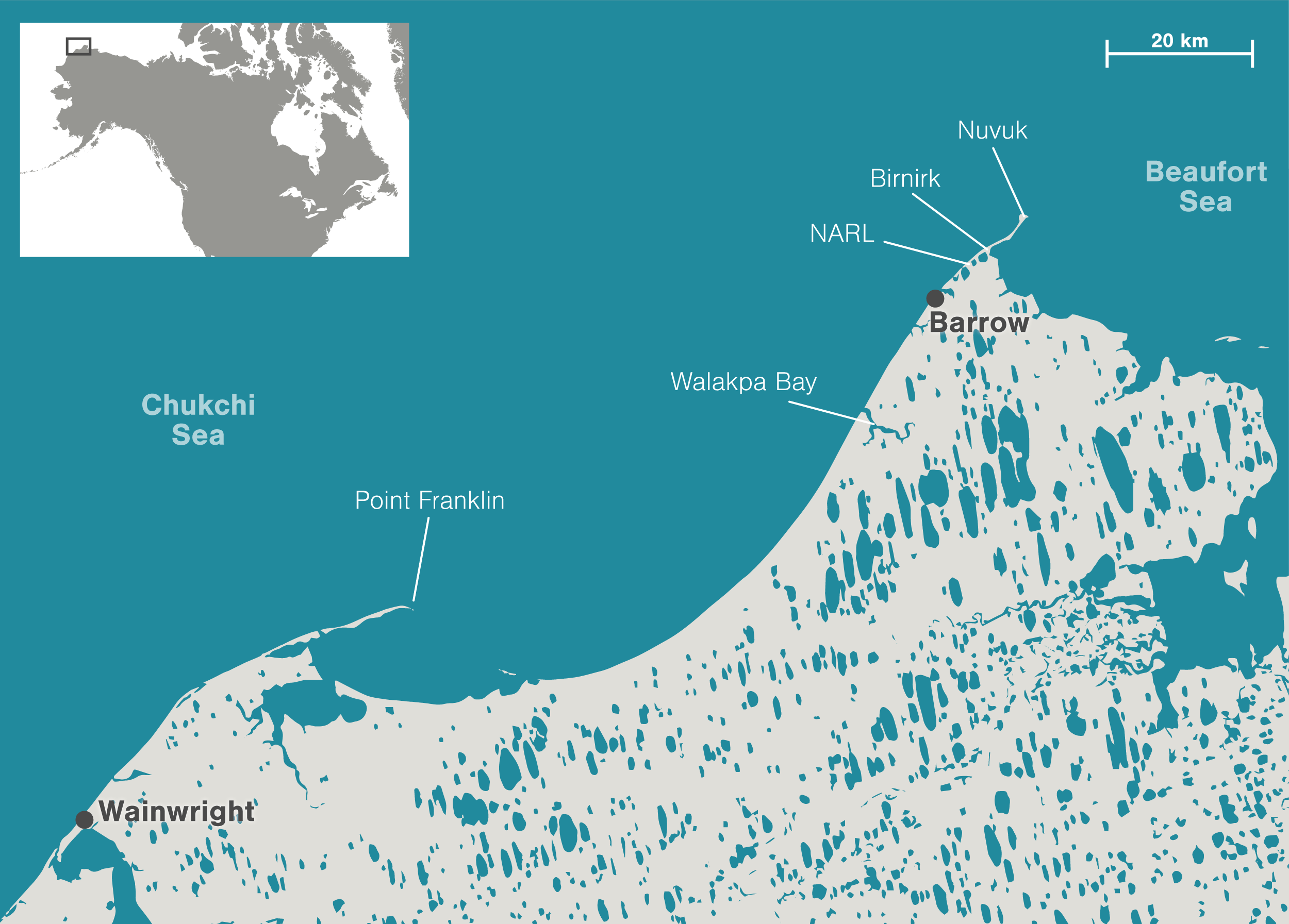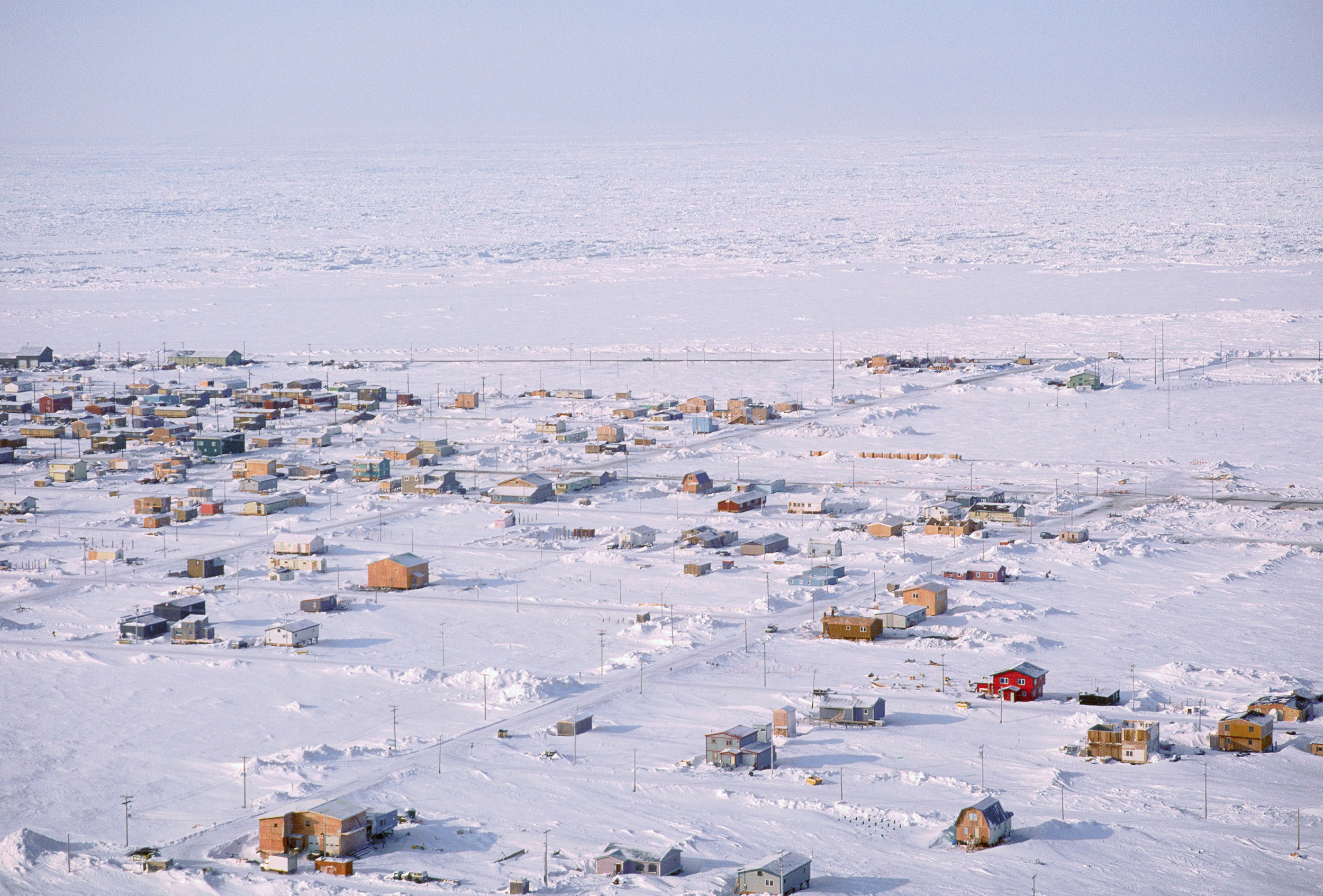History Is Melting
Archaeologists are forced to choose what to save as their dig sites disappear into the Arctic Ocean.
Article body copy
A headless body, stretched out along the beach, appears through the smudged window of our ATV as we sail across the sand. There’s a windy lawlessness up here along the Chukchi Sea; I’m reassured by the rifle lashed to the lead ATV in the caravan. The archaeologist at the helm passes the decaying creature without pause. Anne Jensen has seen many headless walruses before—this one was likely already dead when it washed ashore and was relieved of its tusks. Jensen’s not worried about poachers; the rifle is for polar bears—the Arctic’s fiercest of predators. And Jensen seems entirely capable of staying calm and slamming a bullet into one.
We’re just south of Barrow, Alaska, heading to an archaeological site at a place called Walakpa Bay. It’s a grassy coastline that’s been occupied by semi-nomadic native Alaskans for at least 4,000 years. Their story, told in material remains, is scattered across the landscape we traverse at 60 kilometers per hour, past flocks of ducks and eroding bluffs. Most archaeologists mine the soil to better understand how the animals, landscape, and climate of the past may have shaped a culture. For three decades, Jensen has tried to find and tell the stories locked in frozen dirt here on Alaska’s North Slope, the home of the Iñupiat, as they are known today. But as much as Jensen wishes she could do just that, her most important work on this thawing, eroding land is simply trying to protect what’s left of Walakpa, and other vanishing sites, from a warming climate.
At the world’s edge, the Arctic coastline is on the front lines of climate change. As the length of time ice stays fastened to it has plummeted, the shoreline here has eroded faster than almost anywhere else in the world. Two years ago, villagers alerted Jensen to a storm that had wiped out about half of the Walakpa site. The rest could be erased soon, she says, when the storms whip up again. “It’s like a library’s on fire,” says Jensen, equal parts bitterness and Midwestern matter-of-factness. Jensen is the kind of person who would find the notion of books burning for any reason deeply unjust.
Saving Walakpa properly would require months of encampment, dedicated freezers, and soil engineers. There’s no money for all that. “But you gotta try,” she says. “We need to get this data now.” She’s known up here on Alaska’s North Slope for her thoroughness and respect for local traditions—and perhaps above all, her tenacity. Exhibit number one: this five-day mini excursion, a Hail Mary dig to document and preserve a few artifacts on a shoestring budget. The North Slope Borough government has chipped in a few support staff; an archaeologist from Maryland, a local anthropologist, and a PhD candidate from Ohio have volunteered their time; Jensen gave frequent-flier miles to a geoarchaeologist from Idaho to round out the five-scientist crew. She paid out of her pocket for quick and easy field meals—ramen cups.
Two days before leaving, Jensen rummaged through excavation equipment in a dusty garage. Tendrils of her dark hair, sometimes corralled in a ski cap, fell on the beige overalls she often wears. (They reflect the industrial culture that many Iñupiaq have embraced here on the North Slope.) “Okay, so we packed the toilet paper already,” she said. Though she’s tightly focused out in the field, here her small black eyes roved across shovels and buckets. Much of the gear was purchased a few years ago, back when the grant money flowed. Her phone frequently vibrated. (Her chronically ill daughter and a client—a telecom firm—were apparently competing with the remains of hundreds of generations of native Alaskans for her attention.) “Bungee cords are always good,” she said, and we tossed some into a plastic tub.
A sign on her office door quotes US president Teddy Roosevelt: “Do what you can, with what you have, where you are.” Jensen has made a steady career on the edge of civilization with limited resources, studying archaeological sites before the sea devours them. Over the centuries, Walakpa’s inhabitants have, even more so, exemplified Roosevelt’s credo. They’ve learned the rhythms of the whales and the ice and the birds, and they’ve mastered the art of adaptation to a challenging life at sea and on the tundra. But as our ATV thrums along the hard sand and waves relentlessly crash against the shoreline, I wonder to myself: what does saving Walakpa even mean?

Archaeologist Anne Jensen has worked in the Arctic—racing to save valuable archaeological sites before they disappear forever—for over 30 years. Photo by Joe Van Os
Raised in Ballston Spa, New York, Jensen first came to Barrow in 1983 with her husband, Glenn Sheehan, an archaeologist who no longer works in the field. The richness of high-latitude sites, she hoped, would yield novel archaeological data. An average dig in the lower 48, she likes to say, might yield “a banker’s box full of stone tools.” Permafrost sites, by contrast, allow scientists to “actually see what [inhabitants] were eating.” Alaska’s frozen soils preserve organic materials that provide a wealth of ecological and environmental data. Jensen has built her career in hopes of making new kinds of conclusions about the climate, animals, and hunting behaviors of indigenous peoples that once settled Alaska. Just by living, day-to-day, season-to-season, the ancient tribes Jensen studies “were doing environmental sampling back then for us, going back three, four thousand years.” The DNA she collects hints at population dynamics and migratory patterns. Stable isotopes from bones can provide clues to animals’ diets and their positions in the food web. “If we excavate one of these sites we could fill a 20-foot [six-meter] shipping container full of artifacts and samples. Which we’ve done, by the way,” she says.
Jensen and Sheehan have made a comfy home in Hut 170 on the rusty, old Naval Arctic Research Laboratory campus, known as NARL. New Yorker magazines and coffee-table books on archaeology abound, and outside Jensen tends buttercups and willow in what she calls North America’s “northernmost garden.” But what matters most to her is proximity to world-famous archaeological sites. Birnirk—a National Historic Landmark first excavated in 1936, with some of the first evidence of ancient northern Alaskans—is only a 10-minute drive away. Several kilometers farther up the beach lies Nuvuk, the deserted spit of land at one of the most northern tips of North America, where some of Barrow’s oldest Iñupiaq residents remember growing up. And Walakpa, to the south, may be the most important site in the region, says Dennis Stanford, an archaeologist at the Smithsonian Institution in Washington, DC, whose excavations in the late 1960s and graduate dissertation on Walakpa published in 1976 put the site on the scientific map.
So it’s a heady place for Jensen to serve as de facto town archaeologist. Jensen is an archaeological contractor, her employer a science firm in Barrow that provides research studies and logistics to the local government and visiting scientists. Hers is an almost daily task of evaluating threats to artifacts—and human remains. The ancestors of Barrow’s residents, many in unmarked graves, are found everywhere in the region. That makes archaeology part of the social fiber. And Jensen has become the keeper of this thawing legacy. In 2005, a few dozen archaeologists and volunteers were finishing up a dig at Point Franklin, a coastal site south of Walakpa, when a massive search and rescue helicopter landed on the beach. “People dropped their shovels and their jaws,” recalls Sheehan. “There’s an emergency; we need an archaeologist!” a helicopter crew member called to Jensen. Twenty minutes away, in a village called Wainwright, holes for pilings were about to be drilled in an area where residents thought the unmarked grave of their stillborn child lay. Jensen examined the site for a few hours and declared it free of burials. Jensen knows from deep experience that Iñupiaq oral knowledge is often dead right. “I’d be upset too if someone told me that, but we were glad to allay their concerns,” she says.
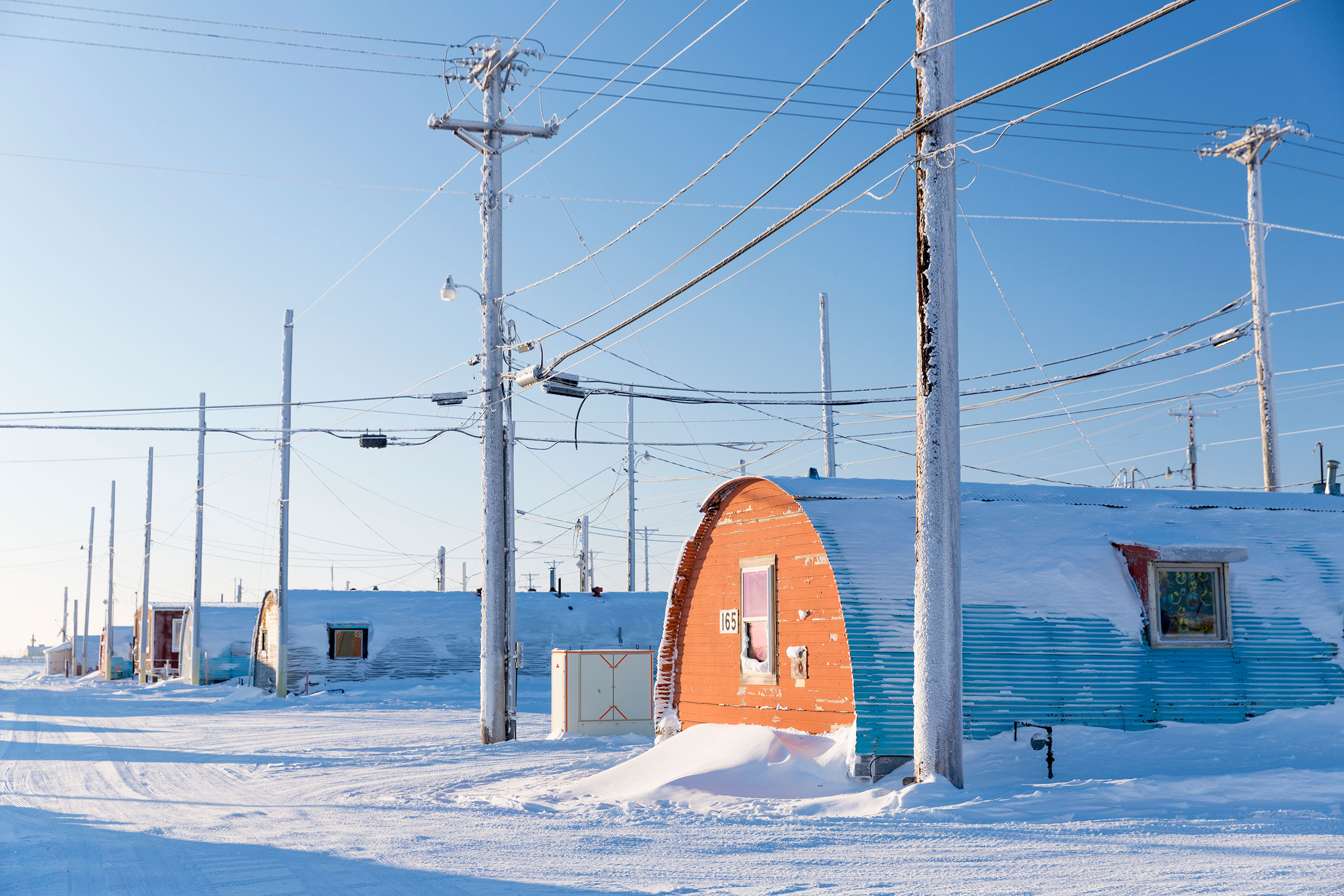
The huts of the old Naval Arctic Research Laboratory campus, known as NARL. Photo by Kevin Smith/Design Pics/Corbis
Indigenous Alaskans have coped with eroding coasts for centuries or more. In 1852, locals told British captain Rochfort Maguire that erosion forced their grandparents to move Nuvuk more than two kilometers inland. So the community was concerned, though not entirely surprised, when in the 1990s human remains began to poke out of a bluff along the Nuvuk beach. The disintegrating coastline was claiming a graveyard that was once far inland. “The wishes of the community were to see [the bones] reinterred near where they were originally buried,” says Jana Harcharek, Director of Iñupiaq Education for the North Slope. Following careful procedures specified by village elders, a team of volunteers and students, led by Jensen since 1997, reinterred the bones. The team has subsequently found and reburied dozens more. “Anne has always been very consultative—she consults with elders and community members about how to proceed. She’s helped the community tremendously,” adds Harcharek.
While Jensen’s efforts at Nuvuk fostered goodwill, the site also proved scientifically valuable. Archaeologists had written off the site as “contact era”—too young to yield important data. Jensen’s work, however, revealed arrowheads of an early culture known as Ipiutak that existed in Alaska until roughly 400 CE. “We were completely surprised,” says Jensen during an afternoon visit to the windswept, empty site. By luck, she’d dug deeper than previous archaeologists—they hadn’t had exposed human remains to clue them in—and warming permafrost had helped, too. She called a bulldozer in to carefully remove top layers, subsequently allowing volunteers to reveal buried wooden Ipiutak structures that had tantalizing detail. But when Jensen applied to the US National Science Foundation to mount a full excavation, her grant application was—like most applications on the first try—denied. “I didn’t bother reapplying because by the time we would have reapplied and gotten funded the land wasn’t going to be there,” she says, pointing at the waves. The soil containing the wooden structures is now tens of meters out to sea.
Jensen nurtures her ties to the Iñupiaq community, and their knowledge has in turn informed her archaeology. She brings her staff, for example, to the early summer Nalukatuq celebrations, in which whaling crews share meat and throw each other in the air with sealskin blankets. That “may not sound like archaeology, but whaling has been the organizing focus of this culture since before most of the sites I work on were formed,” she wrote on her blog. “I really don’t see how one can expect to interpret these sites without a pretty good understanding of what whaling actually entails.” In 2012, she published a paper showing that modern whalers keep their whaling gear outside of their homes; it was an effort to challenge researchers who she felt focused too much on the interior of excavated dwellings, leading to inaccurate conclusions about Eskimo culture.
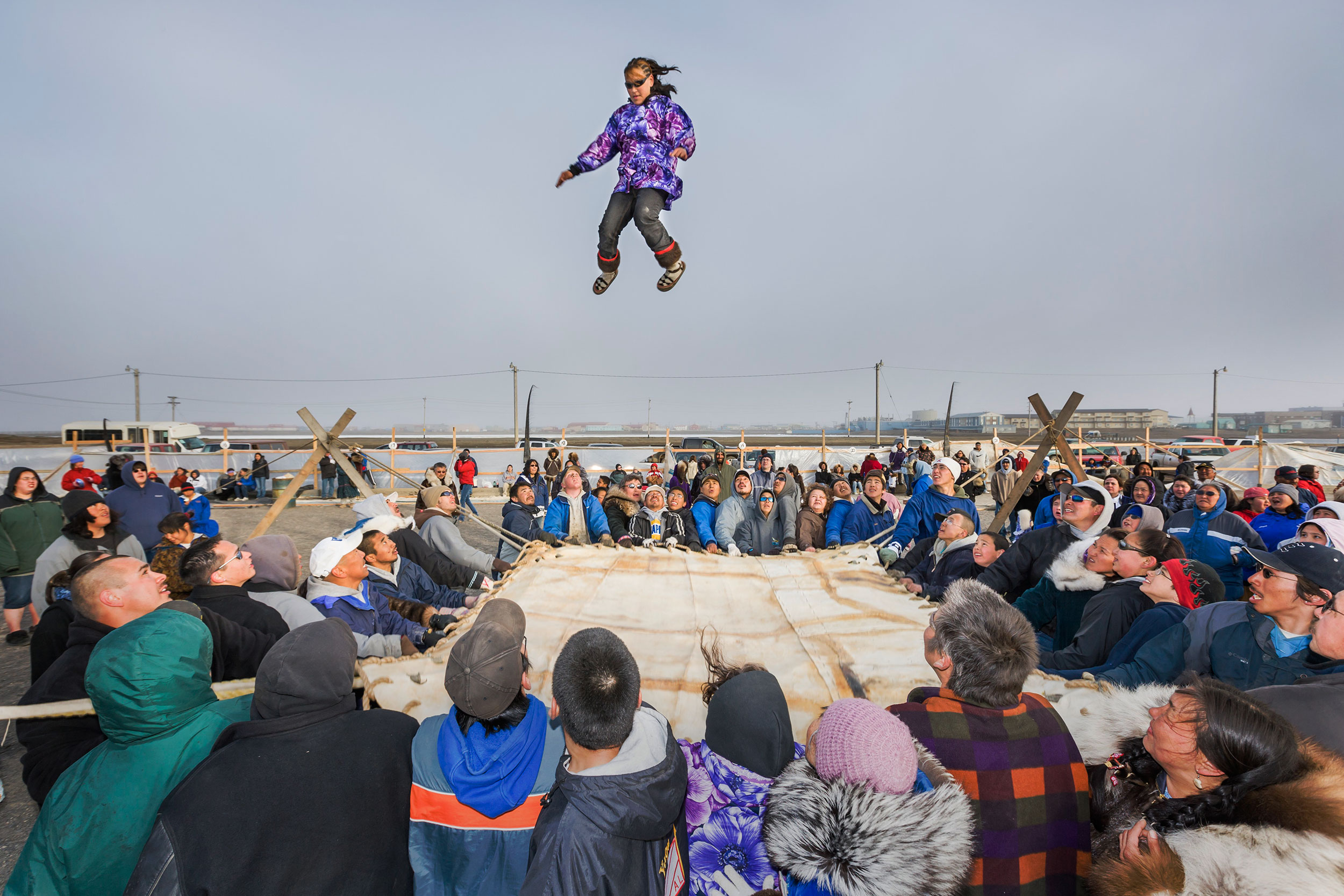
Barrow, Alaska, is a close-knit community of over 4,000 people. The original inhabitants, the Iñupiat, have lived in this area of the Arctic for thousands of years. Photo by Patrick J. Endres/AlaskaPhotoGraphics/Corbis
But a debate over which parts of a site to excavate is meaningless if the site disappears entirely. In 2013, after a summer storm slammed the coast, hunters reported seeing wooden structures protruding from a bluff at Walakpa. For Jensen, the site has special scientific value. Unlike other sites, such as Nuvuk where the occupation record includes gaps, archaeologists believe indigenous people continuously hunted, fished, and camped at Walakpa for millennia. That makes comparisons of flora, fauna, and human culture particularly telling. Its cultural significance is deep too, says Harcharek. “People continue to use it today. It’s a very important waterfowl hunting site in the spring and a regular camping spot.” (Ualiqpaa, as the site is called in the modern Iñupiaq language, means “western settlement entrance.”) Some of the last elders to live at Walakpa remembered complaining about the smell of ancient sea mammal oil in the sod houses. (Many in Barrow call the place Monument; a modest-sized concrete monument there commemorates American humorist Will Rogers and aviator Wiley Post who died when the airplane they were flying for a “happy-go-lucky aerial tour” crashed on the site in 1935.)
What had been a mostly stable site was suddenly at mortal risk. Jensen and a team of volunteers worked in the cold to rescue artifacts as the Arctic Ocean lapped right up to their screening buckets. A ground squirrel had burrowed under the excavation area, destabilizing it further; a polar bear wandered 200 meters in the distance. But the crew’s perseverance paid off. The midden they were excavating yielded clay pottery and tools made of baleen, bone, ivory, and myriad other animal parts.
But the following fall, after a storm, Jensen was crestfallen to find the area of Walakpa she had excavated completely gone. In a damage report she wrote following the storm, she mentioned that the exposed soil allowed looters to steal an ice pick, a bucket made of baleen, and possibly a couple of human skulls. Erosion, however, was the main enemy. “We need to find funds for a field season next year if we do not want to risk losing precious cultural heritage,” she wrote. The rest of Walakpa could disappear at any moment, but at least one archeologist in Northern Alaska wasn’t yet willing to concede defeat.
Funds for a field season have not been found. It is next year. Precious cultural heritage has been lost.
There will be no respite from the waves at Walakpa. There is no strong barrier in place to fully protect Barrow, population 4,400, let alone one to defend this tiny patch of beach that’s known only to the world as the place a pair of Yankees perished eight decades ago.
In lieu of an extended excavation, Jensen has arranged a four-day, five-scientist crew. And in the days before the dig her attention is, as ever, divided. She flies to Kotzebue, 500 kilometers to the south, to do a survey for the telecom company. Then a series of canceled flights keeps her stuck in Fairbanks for a day, her luggage lost by the airline. The dig gets rescheduled and rescheduled again. On the morning of the trip, the packing of the ATVs drags on, with delays for Jensen to send work emails and to collect blood-pressure medication for a member of the team. At Hut 170, she’s fussing over her toiletries. She’s almost out the door when Sheehan says, “And a kiss for your husband?” She stops, smiles, and they share a brief kiss. Outside we all board our vehicles. “Finally,” she declares, “we’re off.”
We arrive at Walakpa after about an hour, in the early afternoon. At the ocean’s edge, the land abruptly ends, forming a high bluff above the sand below. The bluff is cleaved down the middle; from the water, it looks like a 25-meter-wide club sandwich that’s been torn in half. Just last year the bluff, encrusted with artifacts, extended farther out toward the sea by about the length of a small school bus. All that’s there now is salty air.
As the crew unpacks the gear, Jensen lies on her stomach to peer down into the crack, assessing the soil layers that descend to about twice her height and stretch back 4,000 years in time. She lists the dangers to her team: tumbling into the crack, “half a ton of sod falling on you,” “impalement” on stakes, getting crushed by soil. “Nobody goes into the crack,” she declares. Too bad, says geomorphologist Owen Mason, who sees “good wood” of ancient houses in there. Standing in a safe area, Jensen examines the exposed strata. Top layers, still deeper than the researchers went in 1968, could shed light on the most recent occupations. The lower layers could offer clues about when the Paleo-Eskimos first began hunting here. And organic material throughout the strata could shed light on the plants and animals that constituted their world.
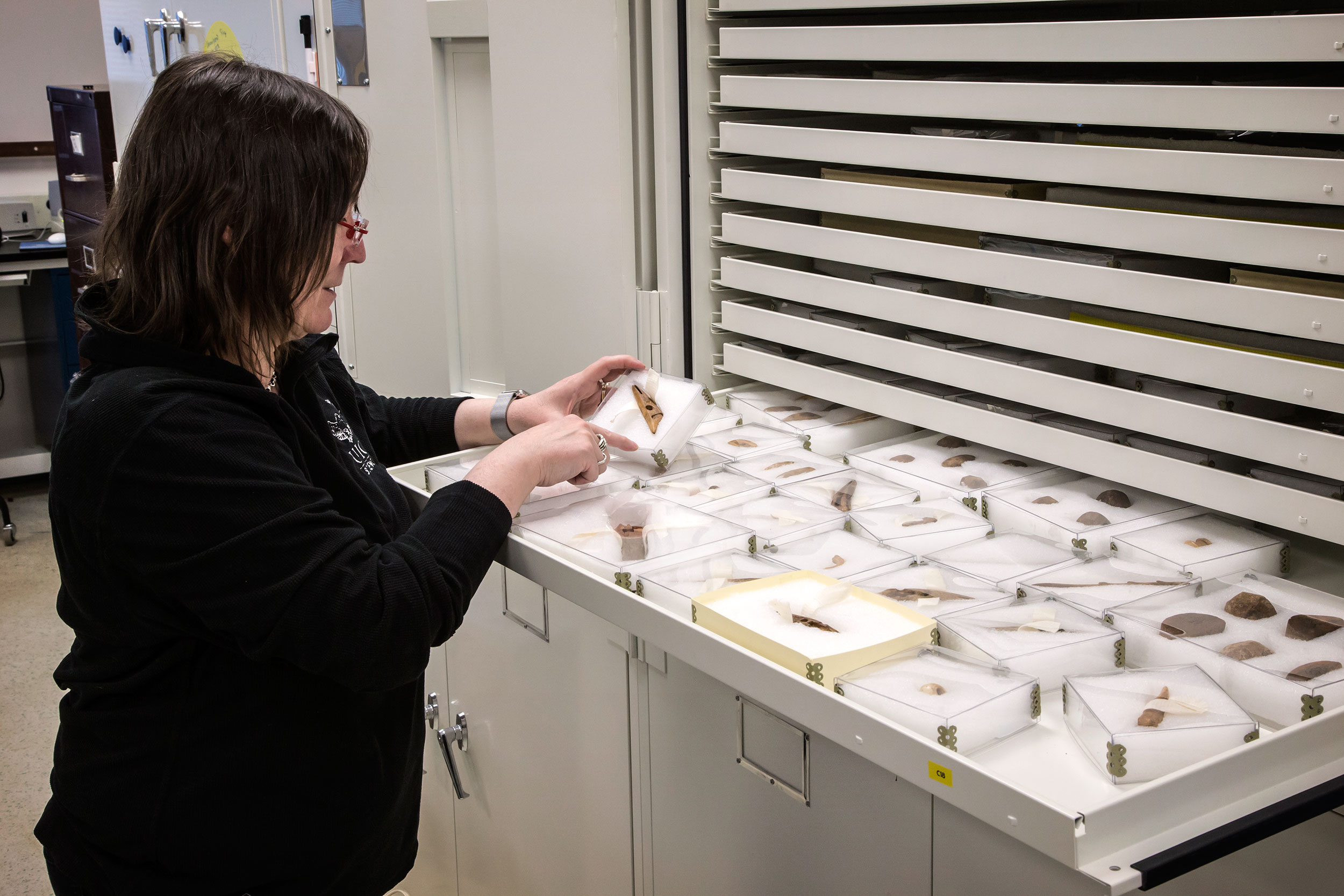
Archaeologist Anne Jensen has the difficult task of evaluating threats to artifacts as the Arctic coastline erodes, taking valuable clues to the past with it. Photo by Joe Van Os
With just five days to work, the archaeological team must make a series of painful decisions. “Ideally you’d like to excavate by hand every last inch of everything,” Jensen admits. A full excavation, painstakingly sifting and sorting each level of the soil, is too time consuming, so Jensen opts to bag a bulk sample from each layer and to screen the rest. The team takes what’s called a column sample, digging straight down along the face of the exposed layers. It allows Jensen to preserve the relative position and stratigraphy of the soil and artifacts from each layer. The team debates how wide to make the column: wider means more chance to find items. But Jensen, informed by experience, knows the risks of ambition when time is short. “I’d rather have a narrow, but full, column sample,” she tells her colleagues. (The column sample also comes at a price: it exposes more layers to thawing and erosion.) They “straighten” the bluff face to remove a dangerous overhang, without screening or storing it. “I feel bad doing it, but there’s only so much time,” mutters Jensen.
The delays mount: while Mason carefully records the kinds of layers in the sample—sand, gravel, midden, and marine mammal fat chilled to the consistency of peanut butter—Jensen has to help the field assistants put up a tent, only to discover key metal pieces are missing. And then a local hunter comes by and stops to chat with Jensen. Finally, the scientists select the site for Column Sample 1, or CS1, which measures about the height of an average doorway and about 75 centimeters wide and deep. Excavation reveals wood chips, modified animal bones, and stone flakes. As they excavate, they map the objects’ positions. They document and put the bulk samples into bags that they’ll lug back to Barrow for future analysis. Jensen will later package and mail a quarter of each sample to Ohio State University in Columbus, Ohio, for the PhD candidate, Laura Crawford, to study. By 2 a.m., the sun has dimmed, though is still up. The team members work until their ability to delineate soil layers dims, too, and then collapse in their tents.
It’s after dinner the next day when Crawford discovers calamity: CS1’s face has collapsed, ruining their work. Later, she says her thoughts ran along the lines of: “Oh shit. What do we do now.” (She was also relieved no one was working at the time. “It could have been disastrous,” she adds.)
“We have to move more quickly,” Jensen tells the others, and then she administers more triage. The team abandons two test layers, just outside the site, that they had been excavating to provide soil comparisons. They begin a new column, CS2—only two-thirds the size of the first—next to CS1, and they dig it with a shovel, not a trowel, taking fewer bulk samples than planned. “Salvage archaeology,” Crawford says.
As the others rush to continue the dig, Jensen commutes back to town on an ATV twice during the week—she’s needed for other work. (“My day job, what are you going to do,” she says.) Before leaving, the group stakes heavy black fabric over the exposed layers to try to protect them from erosion and thawing. “If we don’t get a bad storm, it will be okay. If we do, hasta la pasta,” Jensen says to Mason. Sure enough, after a storm a month later, the half of the “sandwich” facing the ocean is washed away.
The group has long gone its separate ways, back to Idaho and Ohio and Hut 170. Labeled with black marker, the Walakpa bags sit in freezer storage back at NARL. One day soon these bags will be all that’s left of Monument, of Walakpa, of Ualiqpaa. “I’m glad we got the column samples when we did,” Jensen tells me by phone. Do I detect a hint of pride in her voice? Saving Walakpa, it seems, is less about land and more about human determination and dignity. Do what you can, I think to myself, with what you have, where you are.
Reporting for this story was supported by the Pulitzer Center on Crisis Reporting.

